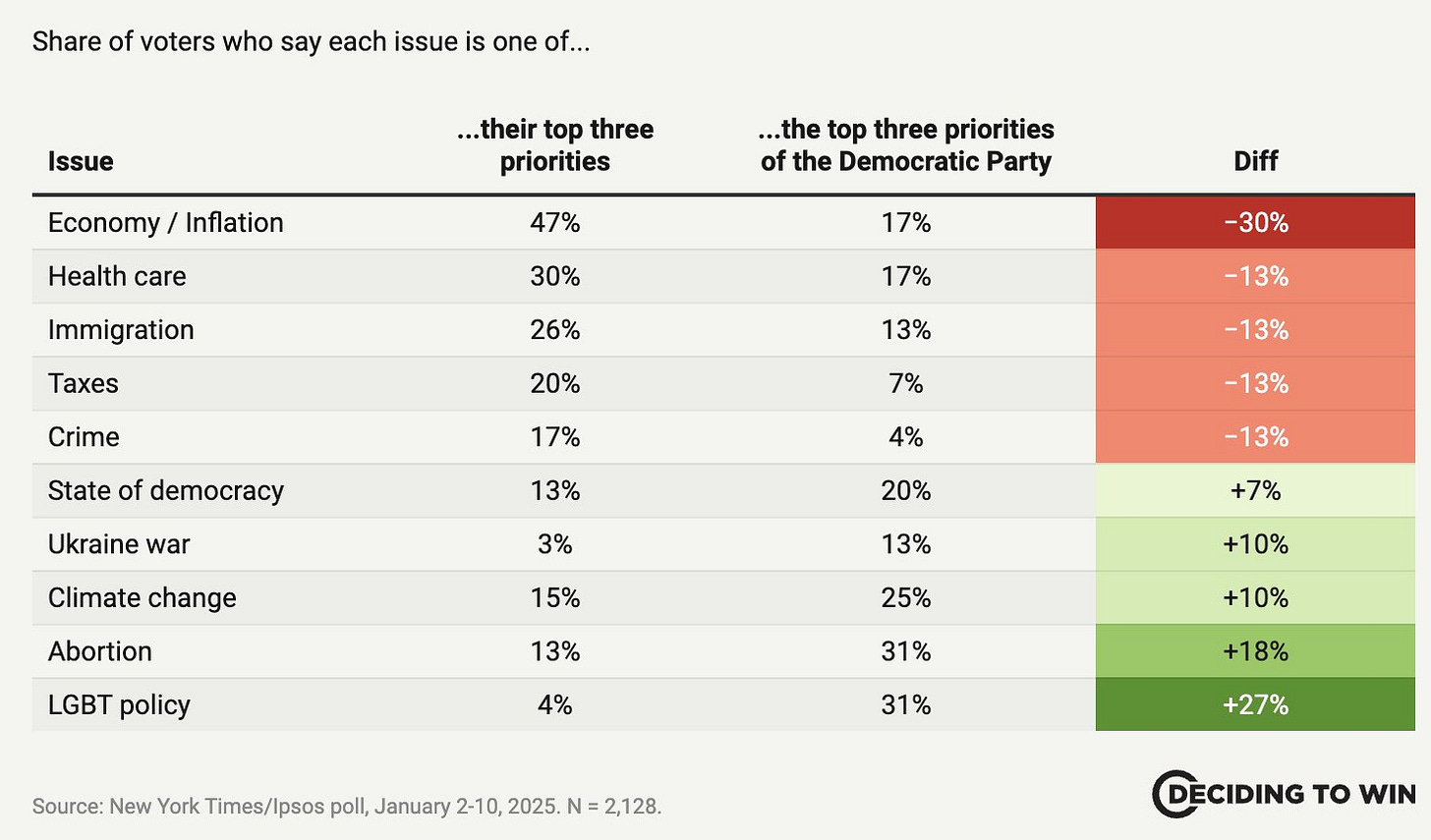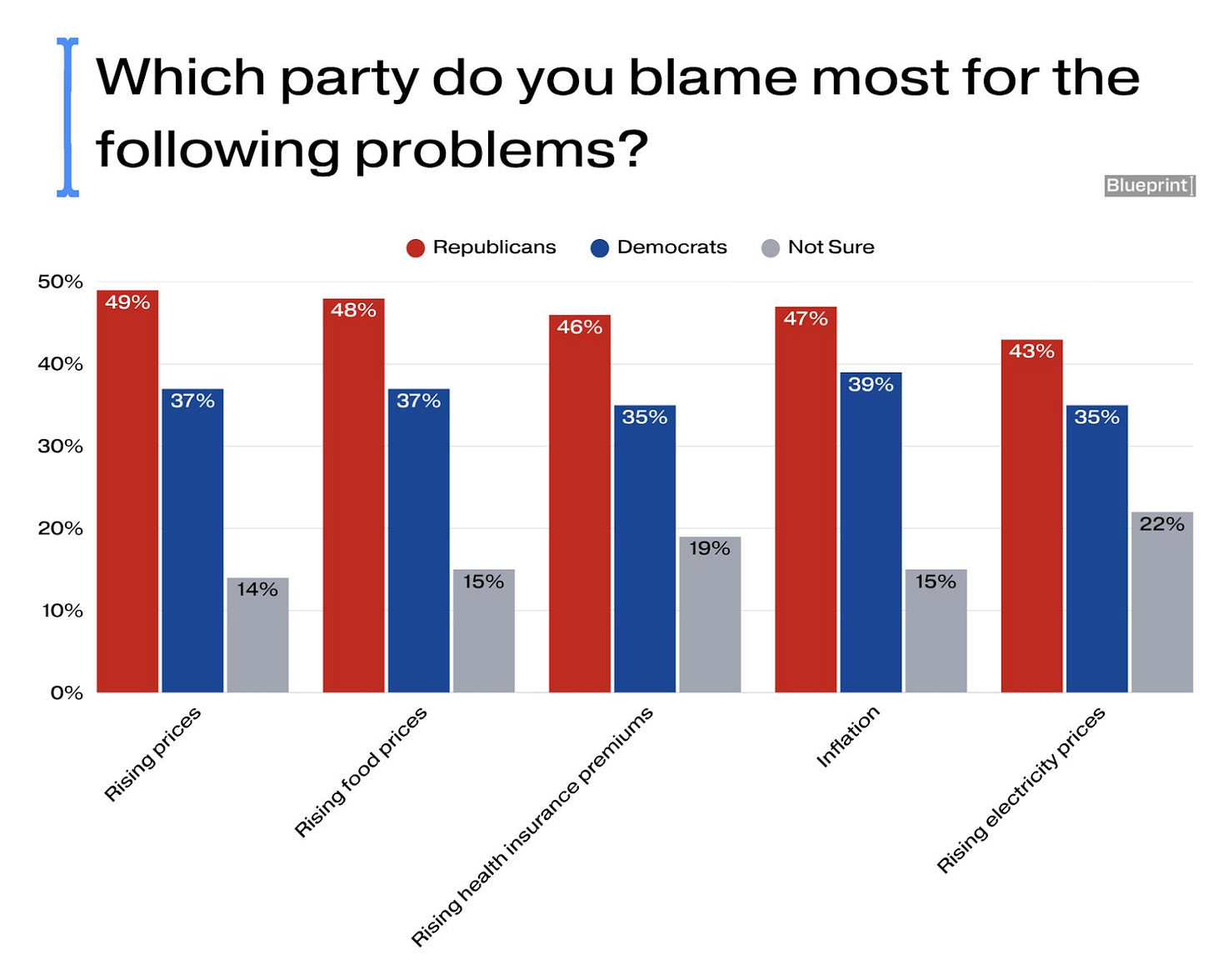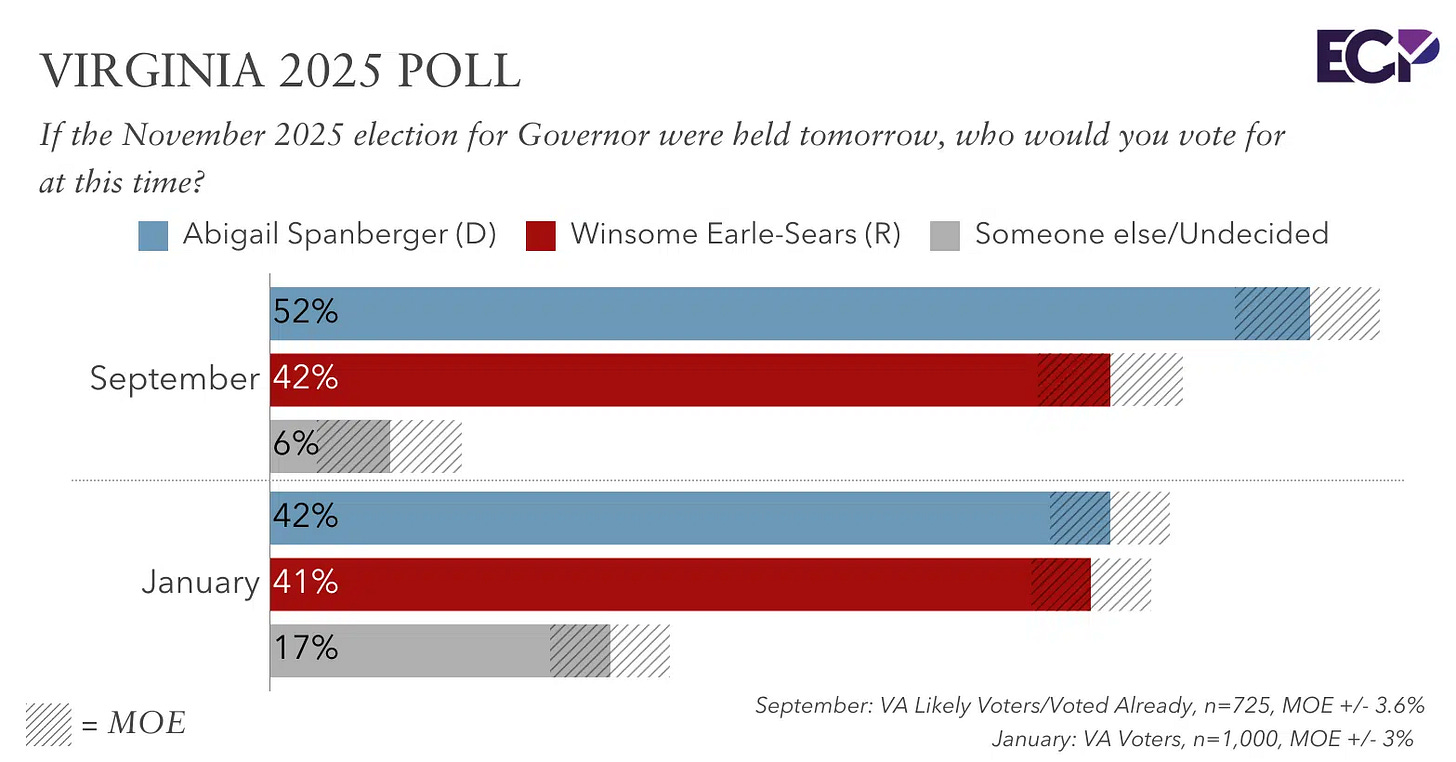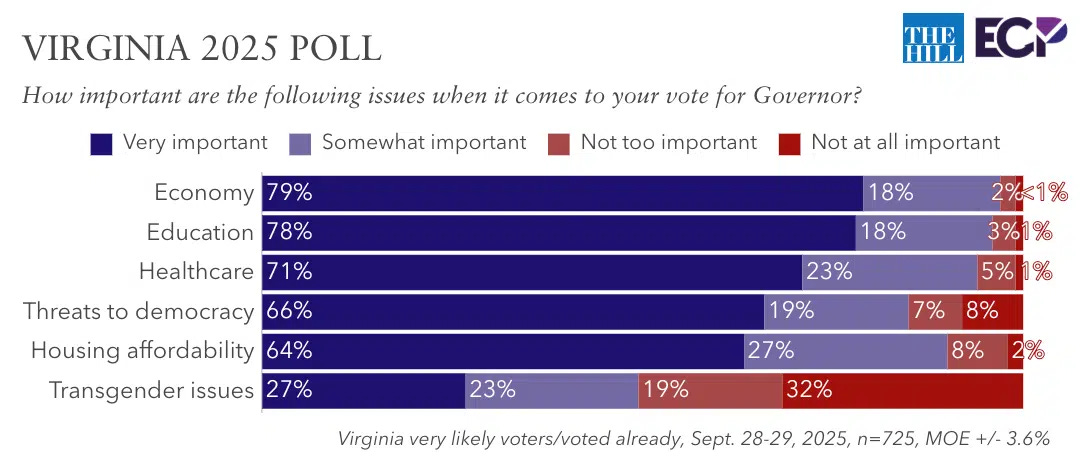Affordability May Be the New Electability
Last week, I wrote about what we can learn from Zohran Mamdani, ahead of the upcoming NYC Mayoral race. There are also two separate high-profile off-year elections this November – the New Jersey and Virginia governor’s races – that feature Democratic women candidates who are bucking the national narrative. Reps. Mikie Sherrill (D-NJ) and Abigail Spanberger (D-VA). Who are both running competitive gubernatorial campaigns in traditionally blue-leaning states. What sets them apart is a laser focus on affordability and the cost of living, an issue voters consistently rank as a top concern, similar to Mamdani’s campaign, yet Democrats appear to continue to miss the mark, having a -30% issue gap here.
Image Credit: Deciding to Win
By zeroing in on pocketbook issues like energy bills, housing costs, and healthcare affordability, Sherrill and Spanberger are crafting a pragmatic, centrist message aimed at a broad coalition of voters. If they succeed, it would not only flip a governorship to Democrats but also offer helpful tips for how Democrats can win in the Trump era by addressing everyday economic anxieties.
The Politics of Affordability
After Donald Trump’s surprise presidential victory in 2024, Democrats have been retooling their message. Candidates like Mikie Sherrill in New Jersey and Abigail Spanberger in Virginia, representing the party’s centrist wing, are positioning themselves as practical problem-solvers focused on economic concerns. Rather than wading into polarizing cultural debates, both are emphasizing relief for families squeezed by rising costs.
“That is the pain point right now with voters,” one Democratic strategist told Reuters — everything from groceries to utilities feels increasingly unaffordable. Seeing an opening, Democrats are framing the election as a referendum on affordability, and, implicitly, on Trump’s economic record. New polling from BluePrint Research shows that as much would like to claim any negative score on the economy is out of his hands, voters are finally starting to label rising prices, and the economy as Trump’s doing.
Image Credit: BluePrint
As Reuters noted, inflation has cooled overall, but essentials like food, housing, and energy remain significantly more expensive than a few years ago. By focusing on concrete cost-of-living solutions, Sherrill and Spanberger aim to reassure moderate and independent voters that someone is paying attention to their pockets and bills.
Crucially, this focus also serves to contrast with their GOP opponents. In Virginia, Republican nominee Winsome Earle-Sears (the current lieutenant governor) has often leaned into hot-button social issues – opposing gay marriage and abortion, for example – “while affordability has been an afterthought in her campaign”. And in New Jersey, GOP candidate Jack Ciattarelli talks about an “affordability agenda” mostly in terms of broad tax cuts and deregulation, but his plans would actually raise costs by undoing clean-energy investments. By keeping the conversation centered on pocketbook issues, Sherrill and Spanberger not only play to their strengths as pragmatists, but also force their rivals onto less favorable terrain.
What Do the Polls Say?
While there has been a lot of chatter online, if these candidates have what it takes to win, looking at polling data allows us to paint a better picture to see how their constituents are responding to the race in real time. Polling across both gubernatorial races shows Democrats holding steady but competitive leads as affordability dominates voter concerns. In Virginia, recent surveys from Emerson College and the VCU Wilder School place Abigail Spanberger ahead of Winsome Earle-Sears by 7 to 10 points, with Spanberger outperforming among independents (+11), younger voters, and suburban men — groups that helped propel Glenn Youngkin’s 2021 victory.
Image Credit: Emerson College
Coincidentally, that same poll also finds that the economy is their top priority, coming in at 79%, showing how hammering an affordability message speaks to voters’ priorities.
Image Credit: Emerson College
In New Jersey, Mikie Sherrill maintains a slimmer but consistent edge over Jack Ciattarelli, averaging a 4 to 6 point lead across RealClearPolitics and Rutgers-Eagleton polling. Quinnipiac’s September poll showed Sherrill up eight, powered by suburban moderates and women who cite cost-of-living issues as decisive.
Image Credit: RealClearPolitics
Both Democrats benefit from high name recognition, centrist reputations, (Spanberger led Communications and Outreach under the Blue Dog coalition, with Sherrill being a part of the New Democrats coalition) and voter fatigue with Trump-era politics, while their Republican challengers face limited traction beyond the party base.
Of course, polls are snapshots and both races could tighten. New Jersey Democrats learned in 2021 not to take anything for granted – Gov. Murphy barely hung on despite polling leads. But the consistent advantage for both Sherrill and Spanberger, across multiple polls and with diverse demographic groups, indicates that they are indeed poised to win. Each has built a coalition that draws from their party’s base and the political center. If Trump’s unpopularity in these states continues to hover over the GOP nominees, that only boosts the Democrats’ prospects further. As one analyst noted, the biggest gift to Mikie Sherrill’s campaign may have been Trump’s return to the White House – it instantly reminded suburban New Jersey why they had turned away from the Republican brand in the first place.. Similarly, Spanberger has capitalized on voters’ fatigue with Trump-era turbulence and economic anxiety to offer a steady alternative at the state level.
The Bigger Picture: Lessons for Democrats in the Trump Era
To be sure, affordability alone isn’t a silver bullet. Voters also consider candidates’ character, experience, and stances on other issues. Both Spanberger and Sherrill bring compelling biographies (a CIA officer mom and a Navy pilot mom – profiles that exude competence and service) which likely bolster voters’ trust in them to handle tough problems. But it’s telling that even their biographies have been folded into their affordability message: Spanberger talks about protecting federal jobs in Virginia from Washington’s chaos, and Sherrill about protecting New Jersey families from price gouging and economic dislocation. They’re making the case that they will be steady hands on the wheel when it comes to household economics, contrasting with opponents they portray as ideologically driven or out of touch on these kitchen-table issues.
Come November, we’ll see if New Jersey and Virginia voters reward this approach. All signs point to Spanberger and Sherrill having the wind at their backs. They have framed 2025 not as a bizarre off-year anomaly, but as a referendum on something immediate and personal: Can your family afford to live comfortably? By convincing enough voters that Democrats will help make the answer ‘yes,’ these two candidates are on the verge of landmark wins that could light a path forward for their party—particularly remarkable considering New Jersey swung 10.0 pts to the right in 2024, and Spanberger would succeed Republican Gov. Glenn Youngkin.








Good essay, small critique: NJ is already governed by a Dem, so Sherrill’s win wouldn’t be flipping a governorship for the party.
“If they succeed, it would not only flip two governorships for Democrats but”